The real intention of the 'Tariff Man' (as Trump calls himself) may not even be to put the 'Tariff King' (as he describes India) on the mat with a knockout punch but to arm-twist the Indian leadership to agree to some multi-billion dollar mega arms deal, argues Ambassador M K Bhadrakumar.

It is improbable that Rahul Gandhi consciously chose Ratha Saptami on February 4, which Hindus believe is the auspicious day that Surya Bhagwan began illuminating the universe and celebrate as His 'birthday', to chastise the Narendra Modi government in the Lok Sabha for the clumsy manner in which it beseeched Washington to wangle an invitation for the prime minister to US President Donald J Trump's inauguration.
The salacious story of frenetic Indian diplomacy was originally attributed to certain American sources in the defunct Biden regime.
External Affairs Minister S Jaishankar promptly hit back to accuse Rahul of lying. His contention was that his extended 5-day visit was to meet two important members of Trump's team and to chair a conference of Indian consuls general.
Now, according to the American version, having failed in that mission, Jaishankar subsequently persuaded the Trump administration to schedule a brief visit for Modi to the White House.
Who was 'lying' or who resorted to white lies became a moot point as Modi was indeed slotted for a meeting with Trump in the Oval Office on Thursday evening.
The entire controversy might have died a natural death except for Trump springing a nasty surprise on Modi by scheduling his announcement of 'reciprocal tariffs' across the board on Indian products exported to the US in a slot just two hours before receiving our PM in the Oval Office.
Presumably, our PM was made to watch on television from Blair House Trump's announcement of reciprocal tariffs against India.
In diplomatic terms, this is a faux pas. In optics, though, it is a snub or a humiliation publicly administered.
Apparently, Trump pre-empted Modi's planned charm offensive to dissuade him from imposing tariffs on Indian products. The government was reportedly considering as a sop to Trump reducing tariffs on more than 30 items and increasing its purchases of US defence and energy products.
But the big picture is really disconcerting. Which is that the Indian establishment didn't read the tea leaves correctly about Trump's intentions and was focused on the photo-op in the Oval Office.
Basically, the foreign policy elites are still unable or unwilling to purge their 'unipolar predicament' despite all rhetorical claims to an independent foreign policy.
The Indian elites' dogged refusal to recognise that an epochal shift is under way in the correlation of international forces is truly astounding.

From the Indian perspective, the critical force correlation ought to have been anchored on Russia's victory in the proxy war in Ukraine over NATO. But, on the contrary, the Indian elites bought into the Western narrative of an impending Russian defeat.
Jaishankar himself kept parroting until lately that there was no military solution while the West already began acknowledging that Russia couldn't be defeated militarily and an irreversible scenario was shaping up.
Today, Russia's stubborn insistence to settle only on its terms is being taken into account even by the Trump administration.
In strategic terms, the Western alliance faces a humiliating defeat. Trump's frantic attempts currently are about avoiding the calamity of inheriting a proxy war which his predecessor had foolishly begun.
India's 'unipolar predicament' blocks rational thinking. Simply put, Delhi made a tidy profit out of the proxy war by sourcing Russian oil and fertiliser at discounted price, while also systematically whittling down to reducing the share of Russian weaponry in the inventory of its armed forces per Washington's diktat.
This trapeze act was thought to be smart diplomacy but in reality, is understood in world capitals, including Washington and Moscow, as a time-serving cynical approach.
Arguably, the real intention of the 'Tariff Man' (as Trump calls himself) may not even be to put the 'Tariff King' (as he describes India) on the mat with a knockout punch but to arm-twist the Indian leadership to agree to some multi-billion dollar mega arms deal.
The US lobbyists in India are pulling all stops to get Delhi to agree to buy its expensive F-35 fifth generation stealth fighter aircraft, which according to a report by US Government Accountability Office last February, would take at least $1.7 trillion to purchase, operate and sustain the F-35 aircraft in its 66-year life cycle due to high maintenance costs and developmental delays.
Evidently, Trump's America First doctrine is resorting to coercive methods to bend the Indian leadership. Such a sordid pressure tactic is ably supported by the hydra-headed US lobby that has penetrated the top echelons of decision-making in the Indian bureaucracy, civilian and military.

Suffice to say, India's predicament and vulnerability vis-a-vis the Tariff Man is completely self-made. This is a wake-up call. Trump has underscored reciprocity as the underlying principle of the US-Indian relationship.
And this is happening hardly within a week of the US Border Patrol chief releasing video of Indians boarding a C-17 military plane in chains and cuffs for deportation to their native country -- and the American embassy in New Delhi rationalising that such inhuman actions are 'critically important' for US national security.
Now it seems a second US military plane is also heading towards India. How many self-respecting nations would have lumped such an insult? The shocking part is that all this is happening under the watch of a hyper nationalistic government.
In a single stroke, the Trump administration has rubbished our elites' delusional fantasies of a US-centric foreign policy. The heart of the matter is that the US doesn't want India to become 'another China'.
The regime change in Bangladesh and the excessive interest in the subcontinent's politics shown by George Soros, who is famous the world over as the patron-saint and financier of 'colour revolutions', are ominous signs of the dubious American agenda to weaken India.
Ambassador M K Bhadrakumar served the Indian Foreign Service for 29 years.
Feature Presentation: Aslam Hunani/Rediff.com
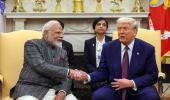
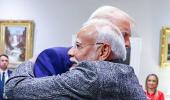
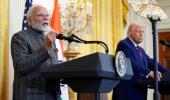
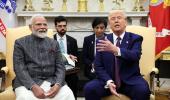
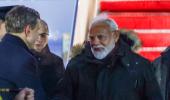




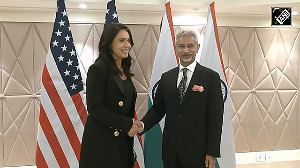
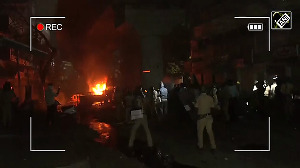
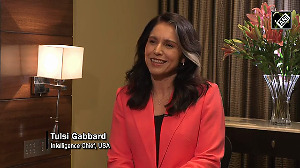
 © 2025
© 2025